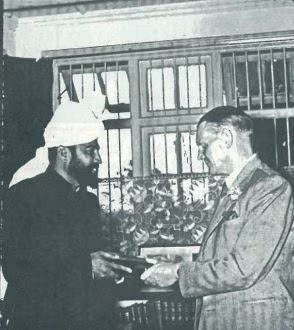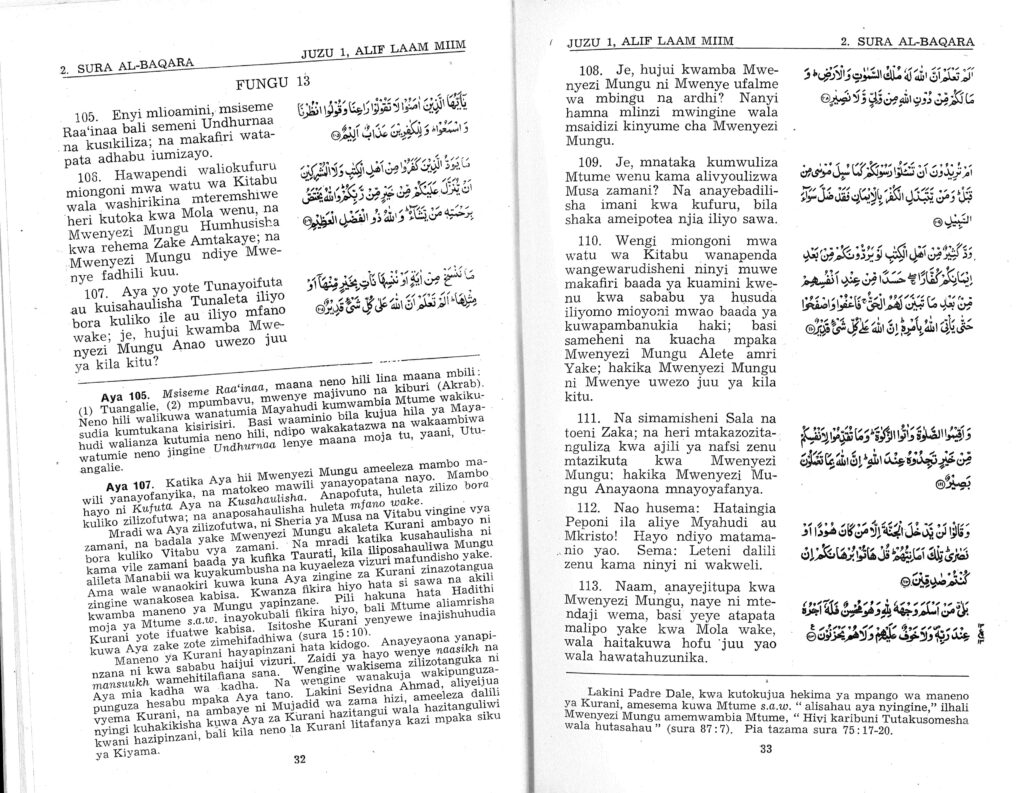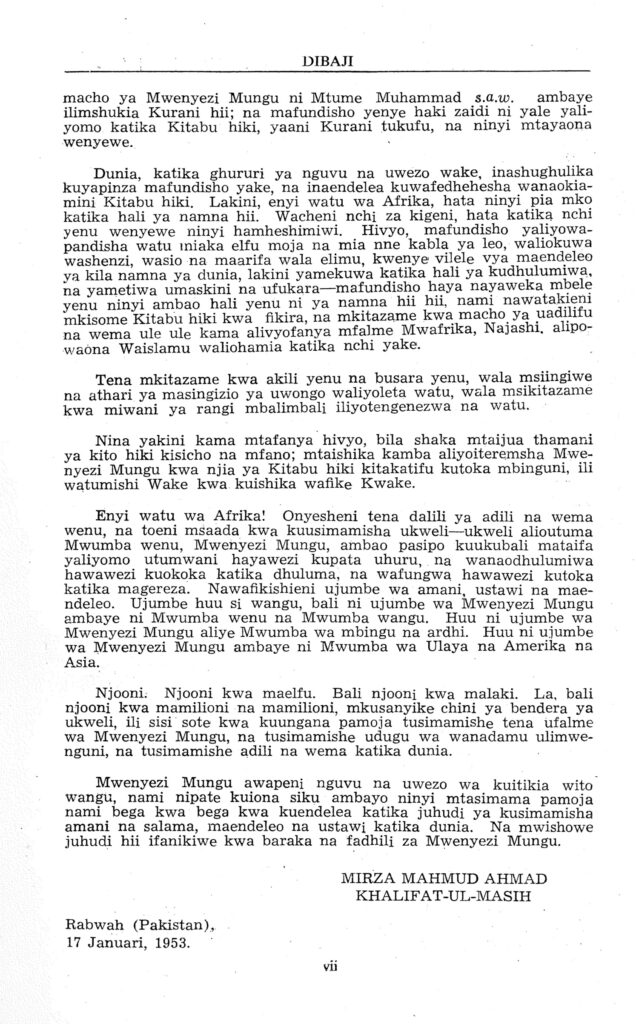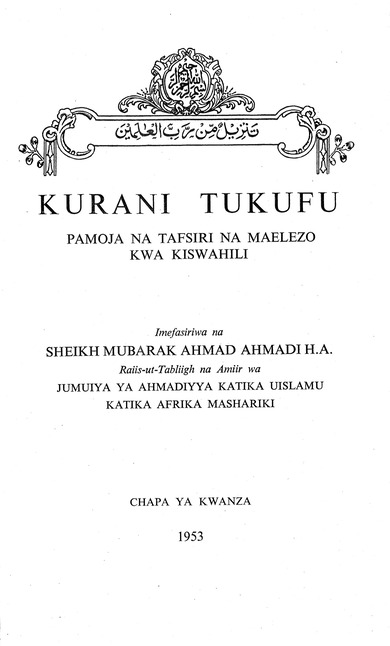
In 1953, Kurani Tukufu, the second ever complete Swahili Qur’an translation, was published in Nairobi, Kenya, which was at that time a British Colony struggling for independence. Begun in the second half of the 1930s, the immediate reason for writing Kurani Tukufu was to provide a counterpart to the Qur’an translation of a Christian missionary, Father Godfrey Dale, which had been published in 1923. Since the author of Kurani Tukufu, Sheikh Mubarak Ahmad Ahmadi (1910–2001), was a member of the Ahmadiyya Muslim Community (or Ahmadiyya Muslim Jamaat, abbr. AMJ), which most other Muslims considered to be heretical, or even outside the fold of Islam, its publication instantly met with heated criticism and, ultimately, the publication of another Swahili translation, written by a Sunni Muslim called Sheikh Abdulla Saleh Al-Farsy (1912–1982), in response to it. But Kurani Tukufu was not only embroiled in intense religious polemics; the AMJ also tried to use it in order to frame the Qur’an as a tool of decolonization and claim a place for Islam in the future of Africa.


All this happened at a time at which the AMJ, also known as ‘Qadianis’ because of the original location of their headquarters in the village of Qadian, were pushing for the production of Qur’an translations for the purposes of daʿwah. They had reason to do so, because the Ahmadiyya movement had gone through a schism in 1914 and the other group that had emerged from the schism, the Lahore Ahmadiyya movement, had already managed to print four complete Qur’an translations between 1917 and 1939, into English, Urdu, Dutch, and German, whereas the AMJ’s projects were still bogged down in lengthy translation and editing processes. Between 1953 and 1955 they finally published five full Qur’an translations, into English, Urdu, Dutch, German – and Swahili. The Swahili translation thus stands out for being the only one that was not at least partly motivated by the desire to catch up with the Lahore Ahmadiyya. There were at least two reasons why a Swahili Qur’an translation was seen as crucially important: First, the extreme commitment of its author, Mubarak Ahmad Ahmadi, and second, the intense level of Christian missionary activities in the region where Swahili was spoken. East Africa had a substantial Muslim population, especially in the coastal regions, but Muslims were not in the majority and Christian missionaries had vastly more resources available to dedicate to proselytisation, especially in the interior. Father Dale’s Qur’an translation was an important tool they used to refute Islam in their evangelistic endeavors. To any missionary-minded Muslim, it constituted a threat.
In contrast to local Muslim scholars, the Ahmadis had a long history of debating Christian missionaries, and from their headquarters in Qadian they had established a program for training missionaries and sending them across the world. Mubarak Ahmad was part of the first generation of Indians to be born into the Ahmadiyya movement, three years after his father had embraced the teachings of Mirza Ghulam Ahmad, and he was a product of Ahmadiyya schooling. In 1934, he was sent to East Africa to establish Ahmadiyya centres and organise proselytisation efforts there, a task which was presumably made more feasible by the presence of large South Asian communities who typically spoke Hindi, Urdu, Gujarati, Panjabi and other South Asian languages as well as Swahili. Mubarak Ahmad remained in East Africa for a quarter of a century, between 1934 and 1960. Keenly aware of the obstacle that Christian refutations of Islam and the Qur’an constituted for Ahmadi missionary efforts, he began working on his Swahili Qur’an translation as early as 1936, probably as soon as he had acquired sufficient language skills. By 1942, Mubarak Ahmad had completed the initial typescript and submitted it for revision to the Inter-Territorial Language Committee, which had been founded by the British in 1930 in order to standardize Swahili. The committee’s judgement of the linguistic quality of the translation was favourable overall. A further revision process involved African scholars of Islam, Swahili speakers and an unidentified recent convert to the Ahmadiyya.


However, the translation did not yet go into publication because at some point in the late 1940s, someone in the AMJ hierarchy decided that the translations that had been drafted so far needed to be accompanied by a commentary. In some languages, such as German, this was limited to a few pages of endnotes, but Mubarak Ahmad launched himself into the task with considerably more enthusiasm. He began working on his commentary in 1949 and ended up producing an enormous amount, roughly as much text as the actual translation. Kurani Tukufu was finally published in 1953 with a print run of 10,000 copies, and sold for 3o shillings, which was a substantial amount of money for inhabitants of the region; a 1955 report by the British authorities estimated that the average wage in rural employment was eight shillings per week.

The Ahmadiyya’s Swahili translation stands out from the movement’s other translations, possibly on account of Mubarak Ahmad’s extreme level of commitment. Every feature of the paratexts – the introduction, the list of references and the footnotes – is extensive and detailed. Moreover, while other Ahmadiyya translations draw exclusively on Ahmadiyya sources and present Ahmadiyya interpretations without any specific reference to their target readership, Mubarak Ahmad’s translation is the only one that explicitly and repeatedly addresses the situation on the ground. It places great emphasis on engaging with Christian missionaries in East Africa, and specifically Father Dale’s arguments, sometimes in notes that extend over several pages. For example, he has a four-page note on Q 5:73, a verse that rejects the Christian notion of the Trinity, in which he discusses and refutes Dale’s linguistic, philosophical and biblical arguments in favour of the Trinity. In another instance, regarding Q 2:16 (ūlāʾika lladhīna shtaraw l-ḍalālata bi’l-hudā fa-mā rabiḥat tijāratuhum wa-mā kānū muhtadīn, ‘those are the ones who have purchased error in exchange of guidance, but their trade has brought no profit, nor are they rightly guided’), Mubarak Ahmad attacks Dale for claiming that this vocabulary reflects Muḥammad’s background as a trader. He (correctly) infers that this statement implies that Muḥammad was the author of the Qur’an. This is, of course, rejected by Mubarak Ahmad who argues that God used these expressions because they relate to everyday concepts that are known to the Qur’an’s audience. He goes on to say:
Moreover, the Qur’an repeatedly provides information about the creation of creatures and the different stages of their creation. Would Father Dale claim that this is because the Prophet was in the habit of creating? Information about construction, blacksmithing, seafaring and various other things is provided by the Qur’an. Would Father Dale claim that the Prophet was a captain, mason or blacksmith?
In Luke 5:37, Jesus says, ‘And no one puts new wine into old wineskins; or else the new wine will burst the wineskins and be spilled, and the wineskins will be ruined. But new wine must be put into new wineskins, and both are preserved. And no one, having drunk old wine, immediately desires new; for he says, “The old is better.”’ […] Following Father Dale’s philosophy, these words of Jesus would show that he was producing alcohol, was even drinking it, and was a drunkard; because Father Dale would question how the information on alcohol, its production and the preservation of its taste could stay in his head.
This type of polemics, where Dale is directly attacked and ridiculed, runs through the notes. Mubarak Ahmad routinely quotes the Bible to refute Dale and prove Christian doctrines wrong; he goes so far as to compares different editions of the Bible to point out inconsistencies, and he draws on additional sources such as encyclopaedias, newspapers and Anglican sermons to underline his claims. At one point, he even polemicizes against the Babi and Baha’i faiths, drawing on Q 11:26 to denounce their prophets as false on the basis that Noah is described in the verse as a ‘clear warner’ (nadīrun mubīn) whereas, according to Mubarak Ahmad, the Babis and Baha’is keep their writings a secret. It may be that this particular piece of his commentary was motivated by the establishment of a Baha’i community in Uganda in 1951.
For the remainder of his notes, Mubarak Ahmad largely relied on Ahmadiyya commentaries in English and Urdu. For the translation itself, which he wrote first, he faced the problem that no authoritative translation by the AMJ had yet been completed when he started his work in 1936. Nevertheless, it is clear that, even though he knew Arabic, he did not write his translation from scratch. Instead, he used a variety of Qur’an translations, including that of George Sale, but he seems to have relied particularly frequently on the translation by Muhammad Ali, of the rivalling Lahore Ahmadiyya, which explains some of his unusual choices. For example, he translates Q 109:7 (lakum dīnukum wa-lī dīnī) not, as Sher Ali of the Qadian Ahmadiyya later did and as many exegetes understand the verse, as ‘For you your religion, and for me my religion’, but as ‘you shall receive your recompense and I shall receive my recompense’ (Ninyi mtapata malipo yenu nami nitapata malipo yangu). This is a clear parallel to Muhammad Ali’s ‘You shall have your recompense and I shall have my recompense.’ However, Mubarak Ahmad did not follow Muhammad Ali slavishly and he sometimes clearly privileged Qadiani interpretations that implicitly or explicitly point to the prophethood of Mirza Ghulam Ahmad, the movement’s founder, over Muhammad Ali’s more mainstream renditions (see, e.g., the translation of Q 2:4 wa-bi l-ākhira hum yuʾminūn).

Another remarkable feature of this translation is the inclusion of a three-page foreword by the caliph of the AMJ, Mirza Mahmud Ahmad, that was written at the request of Mubarak Ahmad and specifically tailored to the local context. Other Ahmadiyya translations either contain no such foreword at all or only a perfunctory and generic one. In his foreword to the Swahili translation, the caliph frames Africa as a special place in the history of Islam due to the fact that the persecuted followers of Muḥammad were made welcome by the King of Abyssinia, which is described as bordering on ‘Kenya Colony’. The King, according to this narrative, listened to a recitation from the Qur’an and judged it truthful and trustworthy, whereupon he offered the believers his protection. The caliph then calls on the speakers of Swahili, the ‘language of learning’, whom he addresses as representatives of the entire continent of Africa, to continue the tradition of protecting those who believe in the Qur’an, to judge it as fairly as the King of Abyssinia did, and to not let the lies and slander that are being spread about Islam deter them. Drawing a parallel between the situation of seventh-century Muslims and that of contemporary Africans, he points to their current oppression and humiliation and presents the Qur’an as the solution, on the basis that 1,400 years ago it was able to bring knowledge, development and civilization to ignorant ‘savages’ and can do so again today. The term that he – or rather, Mubarak Ahmad, who translated the text from Urdu to Swahili – uses to denote the ‘savages’ is washenzi. This is both interesting and problematic because it reflects the contemporaneous Swahili terminology that was used to denote black Africans from the interior lands, who had traditionally been a target of slave raids which had been justified by reason of their alleged lack of civilisation and ignorance of monotheistic religions.
The Caliph’s concluding statement is worth quoting in full:
O people of Africa! Demonstrate once again the signs of your righteousness and goodness, and provide help by upholding the truth – the truth sent by your Creator, God, without whose acceptance the enslaved nations cannot obtain freedom, and the oppressed cannot escape from oppression, and the imprisoned cannot escape from their prisons. I convey to you a message of peace, prosperity and development. This message is not mine, but the message of God, who is your Creator and my Creator. This is the message of God, the Creator of the heavens and the earth. This is the message of God who is the Creator of Europe and America and Asia.
Come: Come by the thousands. Rather, come by the hundreds of thousands. No, but come in millions and millions, gather under the banner of truth, so that we all unite together to re-establish the kingdom of God, and to establish the brotherhood of mankind in the world, and to establish righteousness and goodness in the world.
May God give you the strength and ability to respond to my call, and may I see the day when you will stand with me side by side to continue in the effort to establish peace and security, development and prosperity in the world. And finally, may this effort be successful with the blessings and kindness of God.
This statement clearly ties into the anticolonial discourse that was sweeping Africa in the 1950s. It evokes oppression, the struggle for freedom and the quest for development. Somewhat paradoxically, this anticolonial rhetoric is combined with a paternalistic missionary approach. The aim is to bring the ‘savage’ locals into the fold of true religion, civilisation and education by asking them to believe in the same God who created ‘Europe and America and Asia.’ At the same time, the local situation allowed Mubarak Ahmad to implicitly frame Islam as a liberating, anticolonial alternative to Christianity, which was closely tied to British colonial rule. By the time the translation was published in 1953, Kenya Colony was in the throes of the Mau Mau uprising and the United Nations were pushing for the independence of Tanganyika. The time seemed right to call upon the inhabitants of these colonies to establish ‘the Kingdom of God’ and ‘the brotherhood of mankind in the world.’
Johanna Pink
